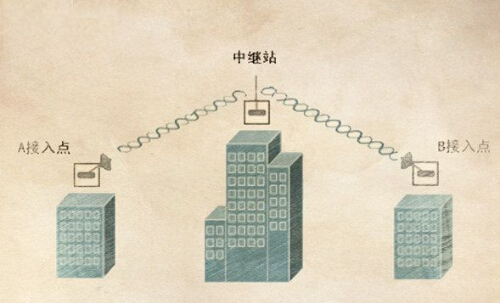Wireless networks are mainly divided into wireless networks (such as 4G, 3G, or GPRS) and wireless local area networks (WiFi) implemented through mobile communication networks. The former mainly uses the wireless Internet access method of the mobile phone network to access the Internet.
What is a wireless bridge?
Wireless bridges, as the name suggests, are bridges of wireless networks. They use wireless transmission to bridge the communication between two or more networks. Wireless bridges are divided into circuit bridges and data bridges from the communication mechanism. In addition to the basic features of wired bridges, wireless bridges work in 2.4G or 5.8G license-free bands, making them easier to deploy than other wired network devices.
From the perspective of understanding the wireless bridge, it can be used to connect two or more independent network segments. These independent network segments are usually located in different buildings and are located within several hundred meters to several tens of kilometers. They can be widely used in different buildings. The interconnection between things. At the same time, according to different protocols, wireless bridges can be divided into 802.11b, 802.11g, and 802.11n in the 2.4 GHz band, and 802.11a and 802.11n in the 5.8 GHz band.
How to set up a wireless bridge? Wireless bridges have three working methods, point-to-point, point-to-multipoint, and trunk bridging. Especially suitable for long-distance communication in the city.
Point to point method
That is "direct transmission". Wireless bridge devices can be used to connect two fixed networks located in different buildings. They generally consist of a pair of bridges and a pair of antennas. The two antennas must be relatively oriented. The outdoor antenna and the indoor bridge are connected by cables. The bridge and the network are physically connected.

Relay mode
That is, "indirect transmission." BC is not visible between two points, but they can be viewed indirectly through an A building. And two points AC, BA between two points to meet the requirements of bridge equipment communications. Relay mode can be used. Building A acts as a relay point. Each BC placed bridges and directional antennas. Point A can be selected as follows: 1. A bridge and an omnidirectional antenna are placed. This method is suitable for the situation where the transmission bandwidth is not high and the distance is short; 2. If point A is a point-to-multipoint The wireless bridge can insert two wireless network cards at the wireless bridge at the center point A. The two wireless network cards respectively connect two antennas through the feeder, and the two antennas respectively point to the B network and the C network. 3. The two network bridges are placed. And directional antenna on both sides.

Point-to-multipoint transmission
Because wireless bridges are often due to special requirements when building a network, it is difficult to find power supplies nearby. Therefore, it is very important to have PoE (Power over Ethernet) capability, such as support for the 802.3af international standard for Power over Ethernet, which can provide 12V of DC power to the bridge via Category 5 lines. The general bridge can be managed through the Web or managed through SNMP. It also has advanced link integrity detection capabilities. When it is used as an AP, it can automatically detect whether the uplink Ethernet connection is working properly. Once it finds that the uplink line is disconnected, it will automatically disconnect the wireless connection. Workstations, thus disconnected workstations can be discovered in time, and search for other available APs, significantly improving the reliability of the network connection, and also provide convenience for the timely locking and troubleshooting. In short, with the maturation and popularity of wireless networks, the application of wireless bridges will also be greatly popularized.
We are pleased to be a supplier of Hitachi Excavator Parts for your Hitachi excavator, track loader or skid steer.
China Hitachi Hydraulic Main Pump,Hitachi Main Hydraulic Pump manufacturers, welcome Hitachi Hydraulic Pump,Hitachi Hydraulic Pump Spare Parts purchasers from worldwide to visit our site.
Hitachi has been providing high quality compact construction equipment for over 20 years. Your Hitachi equipment is some of the finest available, but when a part wears out we want to help you get the parts you need to get your machine up and running again with minimum downtime. All Hitachi OEM parts are available for same day shipment throughout the U.S.
Hydraulic Piston Pump, Duplex Pump, Short-Stroke Pump, Noise/Vibration Reduction, High Self-Priming Ability, Rotational Stability, High Efficiency, High Pressure, Compact Size, Reduction of Overall Length.
We export GENUINE PUMP, OEM PUMP, AFTERMARKET PUMP. We are specialized in OEM PUMP & AFTERMARKET PUMP. We export 95 NATIONS. Please contact us If you need STABLE SUPPLIER.
Hitachi Hydraulic Main Pump,Hitachi Main Hydraulic Pump,Hitachi Hydraulic Pump,Hitachi Hydraulic Pump Spare Parts,Hitachi Hydraulic Main Pump Assembly,Hitachi Main Pump,Hitachi Pump,Hitachi Hydraulic Parts,Hitachi Excavator Part
Jining Juheng Hydraulic Machinery Co., Ltd. , https://www.jhexcavator.com